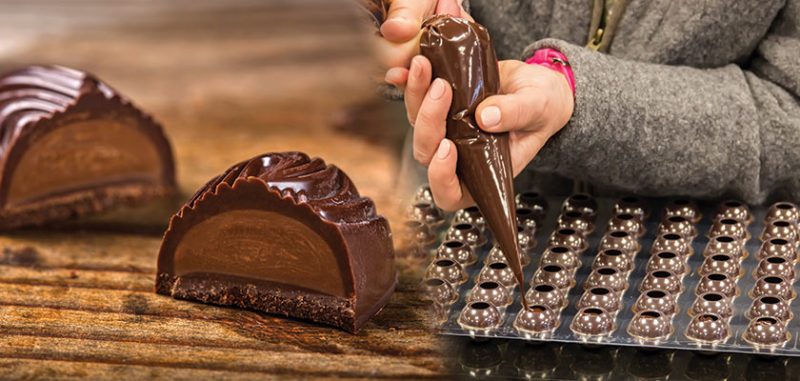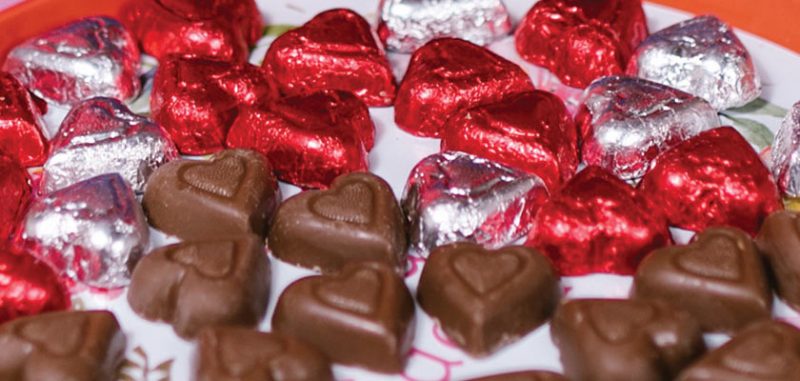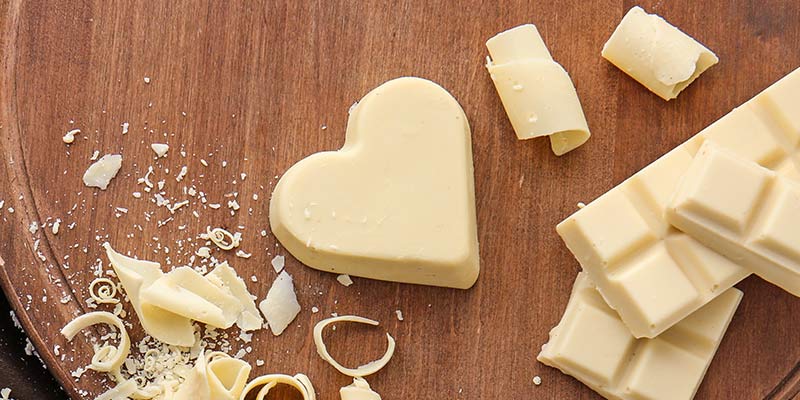If you’ve read anything about chocolate crafting, then you’ve probably heard about tempering. But what is tempering of chocolate exactly? In this article, Chef Prish discusses what tempering is, the science, and why tempering chocolate is vitally important. She also explains how to temper chocolate properly, in preparation for molding or other uses.
What is tempering of chocolate? The science
To understand tempering, first you need to realize that chocolate has a crystalline structure.
Chocolate is made up of 6 crystal structures, (form 1 – 6) each with its own properties and melting points. Tempering is the process of warming, cooling, and agitating chocolate to melt away unstable crystal formations, (form 1 – 4 and form 6) in the fats and reorganize the remaining crystals, form 5, into a stable pattern, called a “crystalline structure.”
Other foods with crystalline structures are butter, margarine, ice, and sugar but chocolate is the only unique one that stays solid at room temperature and melts at 86.72°F/ 30.4°C – 93.92°F/ 34.4°C.
Why tempering chocolate is important
Tempered Chocolate vs Untempered chocolate
Tempering is essential to creating a finished product with incredible flavor, texture, gloss, and clean snap. Well-tempered chocolate will detach from its molds effortlessly. Untempered chocolate, on the other hand, has white blooming on the surface, is dull, greasy/ waxy, or cakey/crumbly, and will stick to its mold.
How to make tempered chocolate
Mise en Place
Tempering requires precision timing, so make sure that you are completely set up for the whole process so as not to interrupt it at any point. Interruptions mean temperature fluctuations, and if this happens, you have to scrap the whole process and start all over again. Set up your space to avoid that:
- Set the room’s ambient temperature to 68°F/ 20°C
- The room’s humidity should be below 50%
- Make sure you have a digital thermometer, scraper, and clean, glass bowls
Different Chocolate Tempering Methods
For tempering chocolate, there are a few different methods you can choose from. They include:
- Tabling
- Seeding
- Sous vide method
- Tempering machine
Next, we will discuss each tempering method and its specific requirements.
TABLING: How to make tempered chocolate using the tabling method
Tabling equipment:
- Equipment: a granite, marble, or stainless steel tabletop
- 10”/ 25cm palette knife
- large scraper
- large stirrer
Tip: Read through all the instructions and do a “dress rehearsal” before working with the real chocolate. Your body has to move in rhythm with the chocolate and moving it from table to bowl without letting it harden takes fluid body motion and positioning. Practice makes perfect. This tabling protocol is based on Chef Haymon, of the Culinary Institute of America’s instructions.
Step 1: 1st Tabling
- Make sure the table and equipment are sanitized and 100% dry.
- Pour ½ of the melted chocolate (114°F /46°C – 122/ 50°C) onto the table and spread it around, from left to right a few times with the palate knife to start forming crystals and to cool it down. It would look like moving a large paintbrush from side to side in long, elegant strokes.
- Using your scraper, draw the spread-out chocolate back into a small circle – this prevents it from hardening.
- Make sure you scrape excess chocolate off the scraper and palate knife each and every time you draw the chocolate in so that it doesn’t coagulate into hardened lumps on your utensils.
- After you gather the chocolate into a circle, spread it out once more, moving your knife left to right a few times. Remember: constant motion is very important to prevent hardening and to organize crystal formations.
- Draw it back into a circle again.
- Spread it out once again, moving constantly from left to right. The chocolate will start to thicken now, as crystals continue forming.
- Draw it back into a circle. The ideal temperature at this point should be 80.6°F/ 27°C.
- Scrape it into the bowl of melted chocolate. Position your body and hand such that you can do it quickly and neatly since the chocolate is quite cooled down and could harden if you are too slow.
- Once the chocolate is in the bowl, stir it well. Make sure you hold the stirrer vertically and not at an angle. Stirring at an angle creates air bubbles.
- The melted chocolate in the bowl increases the chocolate to the tempered temperature of 89.6°F/ 30°C – 32°C. Feel the outside of the bowl after stirring. The chocolate should feel cool to the touch. If it isn’t, do a 2nd tabling.
Step 2: 2nd Tabling
- Follow the all steps above, but this time, pour only ¼ of the melted chocolate onto the table and work much faster. The chocolate is very cooled down and will harden quickly.
- Scrape the chocolate back into the bowl and stir once again, scraping down the sides of the bowl. It will be tempered at 89.6°F/ 30°C – 32°C. Now, do a temper test.
Step 3: Temper Test
- Sink the palate knife into the bowl of chocolate, coating it well. Sit the knife on the table and wait for it to harden. If it has a beautiful gloss, it is tempered. If it has streaks and no shine, it isn’t tempered. If this is the case, move on to 3rd tabling.
Step 4: 3rd Tabling
- Pour an even smaller amount of chocolate onto the table and do the spread-scrape sequence twice, as fast as possible and scrape it quickly back into the bowl. Stir it.
Step 5: Temper Test
- Do a second temper test without removing the chocolate from the first test, so you have a visual comparison, Dip the knife in only ⅓ of the way so you can compare both. The properly-tempered chocolate should have a beautiful gloss in comparison to the dull, streaky untempered chocolate.
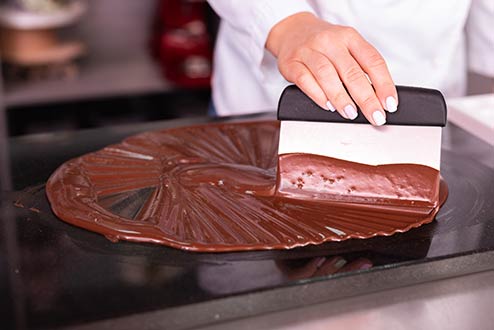
SEEDING: How to make tempered chocolate using the seeding method
The seeding method is pretty easy since you do not need any special equipment. You need:
- melted chocolate (114°F /46°C – 122/ 50°C) in a large, microwavable bowl.
- spatula
- digital thermometer
- tempered dark/ milk/ white chocolate/ callets (small disks of tempered chocolate)
- microwave
The following steps are based on Chef Sarah Tibbetts’s seeding method at Valrhona Chocolate. You will need 20% callets of the total volume of chocolate you are working with. 100g chocolate = 20g callets.
Method:
- Pour the melted chocolate into a large, microwave-proof bowl.
- Add a few callets into it and mix well, holding the stirrer on the vertical, to reduce the temperature and melt the callets in.
- Once the first few callets are melted, add a few more and continue stirring.
- As the chocolate begins to cool, you will add fewer and fewer callets at each round.
- Continue this until all the callets are absorbed. Never stop stirring.
- When you reach 82°F – 84°F/ 28°C – 29°C, pop the melted chocolate into the microwave and bring it up to 88°F – 90°F/ 31°C – 32°C. It should take 15 seconds.
- At this temperature, tempering is complete. Do the same tempering test as you described in tabling.
- If it isn’t tempered, stir more and do another test.
Sous Vide Method
The sous vide method is quite new but produces beautifully tempered chocolate. A sous vide machine is a water circulator with a thermostat and some of them come with a built-in bath. The advantage of sous vide is that it keeps food at the temperature you choose without any fluctuations at all. To temper:
- Seal your chocolate in a waterproof bag. It’s a good idea to use two bags just to be doubly careful. Ziplock bags work well. Just make sure that no water comes into contact with the chocolate.
- Melt the chocolate in the bath at 113°F/ 45°C for one hour or until melted.
- The sous vide machine will make sure the water is actively circulating, but you should also agitate the chocolate through the bags with your fingers. Be very gentle. Sometimes, perforations can be undetectable to the eye but can let water in.
- Once it is melted, scoop some of the water out, add ice in, and set the temperature to 80.6°F/ 27°C. Gently agitate the chocolate a few times.
- Reheat it to 89.6°F/ 30°C – 32°C. Agitate with your fingers.
- The chocolate is now tempered.
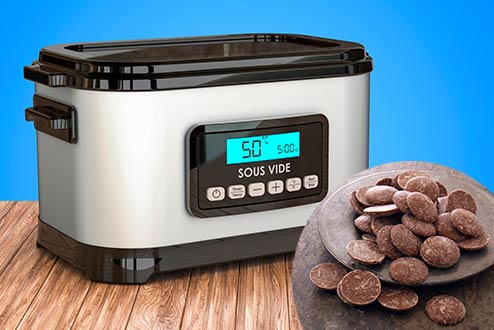
Tempering Machine Method
The tempering machine takes all the guesswork out of tempering. It heats and chills chocolate to the perfect temperatures to reach beta V crystals.
Chocolate Tempering Temperature Chart
No matter what method you use for tempering chocolate, here is a temperature guide:
Melt
| Chocolate | Fahrenheit (°F) | Celsius (°C) |
|---|---|---|
| Dark chocolate | 114°F – 122°F | 46°C – 50°C |
| Milk chocolate | up to 113°F | up to 45°C |
| White chocolate | up to 104°F | up to 40°C |
Cool Down
| Chocolate | Fahrenheit (°F) | Celsius (°C) |
|---|---|---|
| Dark chocolate | 80.6°F | 27°C |
| Milk chocolate | 78.8°F | 26°C |
| White chocolate | 77°F | 25°C |
Reheat
| Chocolate | Fahrenheit (°F) | Celsius (°C) |
|---|---|---|
| Dark chocolate | 89.6°F | 30-32°C |
| Milk chocolate | 84.2°F | 28-29°C |
| White chocolate | 82.4°F | 27-28°C |
Final Thoughts on What is Tempering of Chocolate and How to Do It
We hope you enjoyed this chocolatier technique piece by Chef Prish.
By the end of this article you should now have a good idea of what is tempering of chocolate, why tempering chocolate is important and several tempering methods.
The techniques shown here can be used on your own homemade bean to bar chocolate, or store-bought chocolate if you prefer to keep things easy. In the next article of this series, Chef Prish discusses how to mold and enrobe chocolate, to finish off your beautiful chocolate creations.
Happy Chocolatiering!



